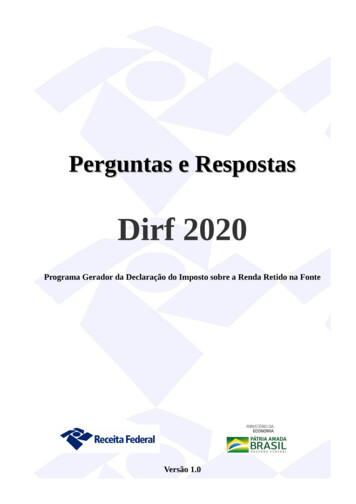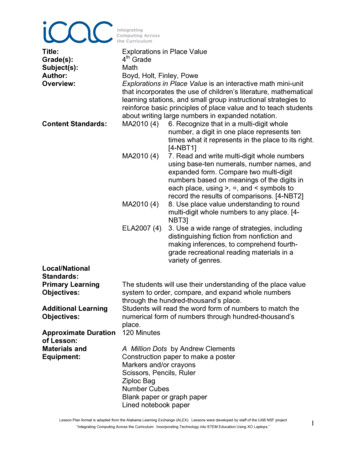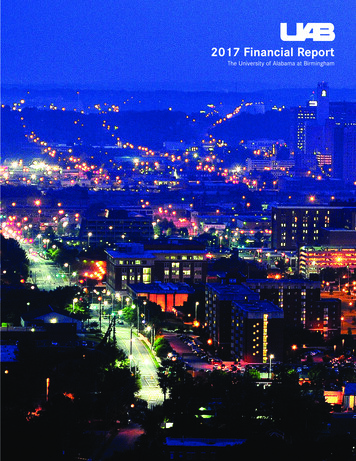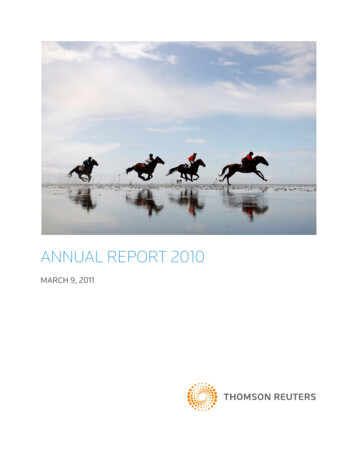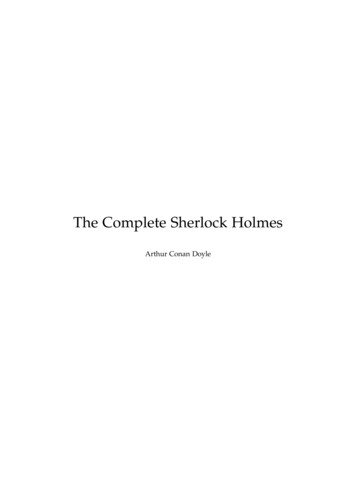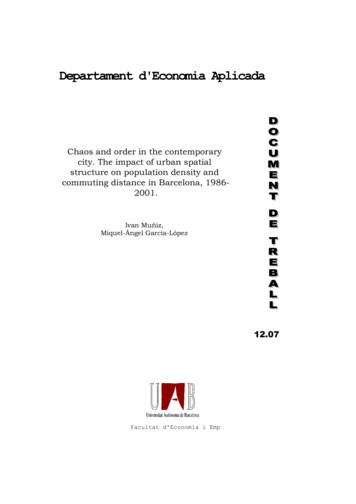
Transcription
Departament d'Economia AplicadaChaos and order in the contemporarycity. The impact of urban spatialstructure on population density andcommuting distance in Barcelona, 19862001.Ivan Muñiz,Miquel-Àngel García-López12.07Facultat d'Economia i Emp
Aquest document pertany al Departament d'Economia Aplicada.Data de publicació : Juny 2012Departament d'Economia AplicadaEdifici BCampus de Bellaterra08193 BellaterraTelèfon: (93) 581 1680Fax:(93) 581 2292E-mail: d.econ.aplicada@uab.eshttp://www.ecap.uab.es
CHAOS AND ORDER IN THE CONTEMPORARY CITY.THE IMPACT OF URBAN SPATIAL STRUCTURE ON POPULATION DENSITY ANDCOMMUTING DISTANCE IN BARCELONA, 1986-2001.Ivan Muñiz and Miquel- Àngel García-LópezAbstract:One of the criticisms leveled at the model of dispersed city found all over the world is its unarticulated,random, and undifferentiated nature. To check this idea in the Barcelona Metropolitan Region, weestimated the impact of the urban spatial structure (CBD, subcenters and transportation infrastructures)over the population density and commuting distance. The results are unfavorable to the hypothesis ofthe increasing destructuring of cities given that the explanatory capacity of both functions improvesover time, both when other control variables are not included and when they are included.1. IntroductionThere is widespread consensus on the limitations of the model of Monocentric CityModel when reflecting the complexity of the dispersed city (Krugman, 1996; Anas etal., 1998; White, 1999). However, the existence of employment subcenters,metropolitan corridors, or any other element on which urban sprawl settles unlike thetypical continuous, dense urban grid has been interpreted from two differentperspectives. The former upholds that the elements that make up the urban spatialstructure do not actually order the space, so the settlement pattern, densityconditions, or mobility patterns tend to be expressed in an increasingly random form(Pope, 1996; Dear and Flusty, 1998; Boeri, 2001; García, 2010). The latter, which canbe found in the majority of polycentric models of the New Urban Economics (NUE),posits an alternative framework in which the employment subcenters replicate thefunctions of the traditional Central Business District (CBD), albeit on a smaller scale,thus contributing to organizing the urban peripheries (Sullivan, 1986; Wieand, 1987;White, 1999).The discourse on the destructuring of the urban space has served to stimulate a newwave of studies in which the traditional idea of the tree structure common tohierarchical systems has been replaced by the fractal or rhizome structure (Nijkamp
and Reggiani, 1998; Batty, 2005). To the contrary, no interest seems to have emergedamong those working within the framework of the NUE to empirically check whetheror not their models, based on the idea of structuring, tend to lose validity over time,which is strange given that the destructuring of the city approach entails a challenge toits postulates.The empirical exercise performed consists of estimating a population density functionand a home-work commute distance function using the distance to the employmentcenters (CBD and subcenters) and transportation infrastructures as regressors, alongwith some control variables, and then to later examine the changes experienced by themodel’s adjustment fit over time. The city studied is Barcelona and the period is 19862001. Put simply, should the hypothesis of the destructuring of the city be provencorrect, we should notice a drop in the overall explanatory capacity, most likelyaccompanied by waning confidence levels in the regressors associated with urbanspatial structure.This exercise was planned as an attempt to provide empirical evidence related to theurban destructuring approach. Of course, it is just a partial examination which does notaim to validate or reject such a complex approach in terms of the variety of argumentspresent in the discourse and the subtlety with which they tend to be wielded; rather itis merely an attempt to check those implications which are liable to being analyzed aspart of the polycentric models of the NUE for the case of Barcelona, specifically itscapacity to predict the population density and commuting distance. Unfortunately, wehave not managed to find any study with which to compare our results. There is, ofcourse, extensive literature on the impact of centers and transportation infrastructureson both the population density (Baumont et al., 2004; Muñiz et al., 2008) and oncommuting distance (Levinson and Kumar, 1997; Wang, 2000; Naess, 2007). However,most of them are static studies (for just one year) and/or partial studies (only onevariable is examined, either density or commute).The results indicate that far from losing their structuring capacity, the influence oftransportation infrastructures and centralities has tended to rise in Barcelona,rendering it possible to better predict the population density and commuting distances
in 2001 than in 1986. These results should be interpreted as coming from an urbanregion immersed in an intense process of metropolitan integration, where mediumsized cities that could be described as Christallerian subcenters have been absorbedinto the radius of action of the main city, Barcelona.2. Urban destructuringNumerous voices, mainly from the field of urban planning, have stressed theincreasingly amorphous and chaotic nature of urban space. The decentralization ofboth the population and jobs are generating a model of city in which the elements thatwere traditionally regarded as its basic skeleton – centralities and transportationinfrastructures – are no longer exercising their structuring capacity. Morphologically,the urban space would resemble a labyrinth or a meaningless puzzle. To describerecent urban dynamics, Pope (1996) wields the concepts “entropy” and“disorganization”, Boeri (2001) cites “undifferentiation”, Batty (2011) claims a “lack oforder”, García (2010) notes “randomness” and Dear and Flusty (1998) describe“disarticulation” and Phelps (2004) “undifferentiation”. All of these concepts revolvearound the same idea, namely the rising destructuring of the city.1From the outset, we should distinguish between the Destructuring of the CityApproach and the Dissolution of the City Approach, which bear similarities to eachother as well as major differences. According to the latter approach, improvements inthe transportation and telecommunications would make physical distance less and lessnecessary, especially for jobs (Mitchell, 1995; Lang, 2003). This idea has been hotlydebated and has merited in-depth research comparing the evolution of jobs inside andoutside the centers (Gordon and Richardson, 1996; Pfister et al., 2000) and moreclosely examining employment figures with the purpose of discovering whether thereare activities that are particularly resistant to the forces leading to de-concentration(Lee, 2007; Muñiz and García-López, 2010, García-López and Muñiz, 2010). In both1The forerunners of this disorderly version of urban sprawl date back to the 1920’s. We must first citePatrick Geddes (1920), who claimed that cities had to stop growing like oil stains and instead follow analternative growth model he described as botanical. Later, in the 1950’s and 1960’s, the comparisonbetween sprawl and disorder remained alive. W.H. Whyte (1958) held that the problem of sprawl wasthe lack of order or a pattern, while Lewis Mumford (1961) believed that the American city was turninginto an undifferentiated amalgam.
cases, the purpose is to weave a discourse on the future of the urban form based onrecent trends. However, while the urban destructuring approach upholds the existenceof rising morphological and functional disorder, the urban dissolution approach holdsthat the future will bring the total dispersion of both the population and jobs. In short,the destructuring of the city approach does not deny the future viability ofemployment centers; rather it underscores their rising inability to coherently organizethe metropolitan system.Albert Pope: LaddersIn his book Ladders, Albert Pope (1996) explains the model of urban growth that canbe found in many cities in the United States as a peculiar mutation of the two othermodels of regional urban planning that emerged during the modern period, namelyArturo Soria’s linear city and the polycentrism with which Howard accompanied hisdefense of the garden city (Gravagnuolo, 1998). According to Pope, the dispersegrowth of cities and their increasing disorder can be viewed as the failure of thesemodels that attempted to articulate and impose a hierarchy on the city space.In contrast with the traditional grid, which is regular yet also ready for unlimitedgrowth in the expansions of 19th century European cities and in newly built Americancities, transportation infrastructures and new subcentres became fundamentalelements in urban expansion in the second half of the XXth century. Yet far fromorganizing the space on the metropolitan scale, all they managed to do was to affecttheir most immediate environment. As a result, the urban morphology that tended toemerge is described by Pope as a weak metropolitan form.2According to Pope, Urban sprawl would be expressed today as a process that managesto lower the entropy in some parts of the urban space (business districts, housingdevelopments, shopping centers, etc.) at the expense of maximizing the entropy of therest of the territory. The disorder that accompanies urban sprawl reaches its maximalexpression precisely in the intersticial spaces, areas without any apparent meaning, cutoff from their surroundings, which in some cases have been painted as a2Today, as an expression of their increasing in-ability to structure the space, they are regarded as yetanother of the “strange attractors” of a city lacking differentiated, specialised organs (García, 2010).
representation of the failure of the disperse urban model and in others have earned asincere interest in understanding their meaning and possibilities. The names that it hasbeen bestowed are as varied as post-architectural void (Koolhaas et al., 1995), smoothspace (Deleuze, 1989), terrain vague (Solà-Morales, 1995), space of ellipsis (Pope,1996), non-places (Augé, 1994), and banal spaces (Phelps, 2004).Urban spatial structure beyond the CBD: polycentricity and linear expansion inRegional Planning tradition and NUE modelsPope’s vision of urban sprawl as a process characterized by its increasing lack of orderand hierarchy, in which the bones of the urban skeleton are incapable of holding up arecognizable structure because they are broken, disconnected, scattered aboutwithout either order or meaning, generating something like many tiny tumors aroundit, is shared by the majority of applied studies on urban sprawl coming from the USA.For example, Galster et al. (2001) and Glaeser and Kahn (2004) include linear growthand polycentrism as two further dimensions of sprawl, along with low density, deconcentration, and discontinuity. In this kind of study, the assimilation of linear growthand polycentrism as elements common to urban sprawl contrasts with theexperiments conducted in numerous cities – mainly in Europe – in which linear growthand polycentrism are the expression of a conscious struggle through urban planningagainst undifferentiated, amorphous sprawl lacking any hierarchy (Hall, 1996; Hall andPain, 2006; Gravagnuolo, 1998).Nor does Pope’s approach match what could be expected of a process of polycentricdecentralization of employment according to the majority of models of the New UrbanEconomics (NUE). In the polycentric theoretical models of the NUE, just like in thestandard monocentric model, the city is arranged in an orderly fashion around the CBDand the subcenters, even though this is a spontaneous order that emerged from theindividual economic rationality of the agents instead of from urban planning. In thiskind of models, the proximity to subcenters is viewed positively by companies andworkers, the former to access part of the agglomeration economies generated there ata low cost, and the latter to minimize commuting distance. On the other hand, theemergence of subcenters can be explained as the outcome of a precarious balance
between agglomeration economies and diseconomies (Sullivan, 1986; Wieand, 1987;White, 1999).In this kind of models, the ideas on structuring and order take on a very specificmeaning. The centralities, CBD and subcenters, are the spatial references for the restof the territory. All the relations and valuations established give rise to a space where,were there no geography, nor history, nor market regulation, it would be perfectlypossible to predict some basic parameters such as population and employmentdensity, land value, or commuting distance for any zone in the city according to itsproximity to the CBD and employment subcenters. This approach to polycentrism –which can be extended to other theoretical models of linear urban expansion (Anasand Moses, 1979, Baum-Snow, 2007b) assume the existence of a structure or askeleton which is capable of sustaining, orienting, organizing, and hierarchizing thedecentralization of the population and employment.The empirical evidence of the impact of centralities (CBD and subcenters) and oftransportation axes on the population density confirms their structuring capacity in themajority of cases. There are numerous studies where the distance to subcenters andtransportation axes exert a significant negative effect on the population density (Song,1992; McDonald and Prather, 1994; Small and Song, 1994; Baumont et al., 2004; Muñizet al., 2008; Steen, 1986; Baum-Snow, 2007a; and García-López, 2010, 2012).3 In thecase of the impact of employment centers and transportation axes on commutingdistance, the empirical evidence offers contradictory results. Even though in studieslike Tkock and Kristensen (1994), Levinson and Kumar (1997), Wang
Albert Pope: Ladders In his book Ladders, Albert Pope (1996) explains the model of urban growth that can be found in many cities in the United States as a peculiar mutation of the two other models of regional urban planning that emerged during the modern period, namely Arturo Soria’s linear city and the polycentrism with which Howard accompanied his defense of the garden city (Gravagnuolo .Cited by: 1Publish Year: 2012Author: Iván Muñiz, Miquel Angel García
